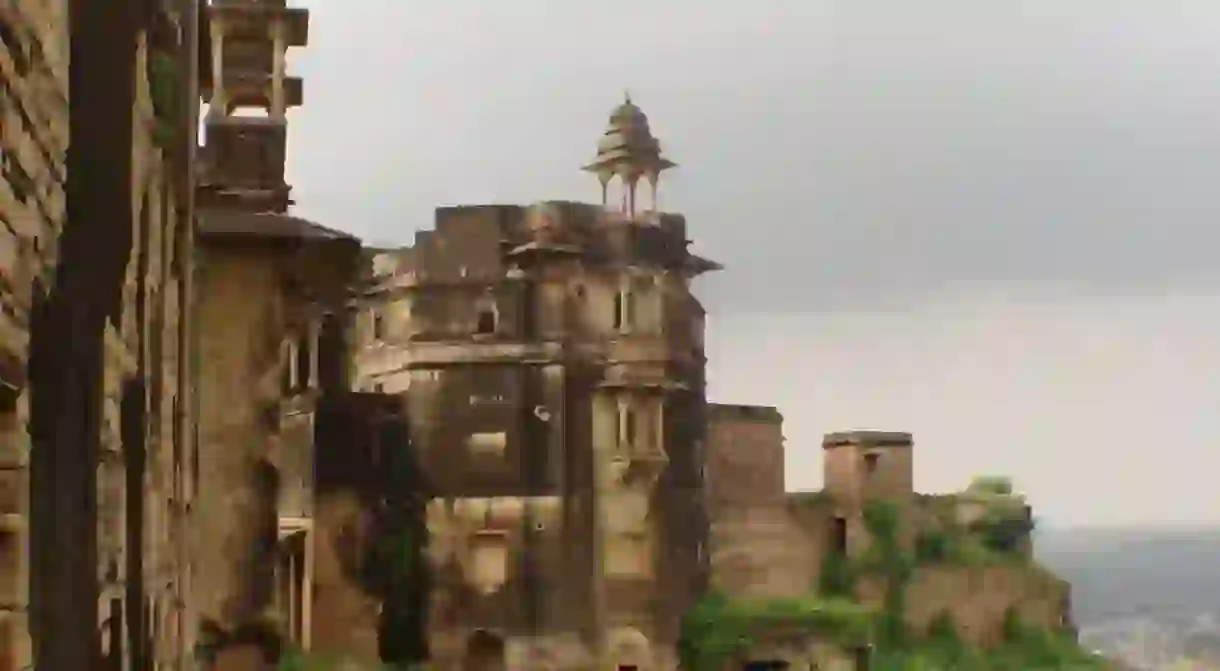11 Impressive Architectural Landmarks in Gwalior, India

The city of Gwalior has been a witness to many historical events. And the reflection of its glorious past can be seen in a number of architectural remains spread across the city. From temples and shrines to museums and palaces, dive deep into the bygone era as you go exploring the most impressive architectural landmarks here.
The Gwalior Fort

Gwalior Fort is the most famous architectural monument of the city. Built in the 10th century, it is the most impenetrable fort of India, and has been ruled by many dynasties in the past. A great number of historical remains from ancient days can be found inside the fort complex. Two massive gates to the fort, called the Hathi Pul (Elephant Gate) and Badalgarh Pul, are also a center of attraction here. After touring the fort, in the evening, you can enjoy the light and sound show too.
Sahastrabahu Ka Mandir

Sahastrabahu Ka Mandir or the Sas-Bahu Temple is a twin temple built in the 11th century near the Gwalior Fort, in dedication to Lord Vishnu. It is a three-story temple with intricate designs and carvings on the inside and outside walls—definitely a must-visit site for historians and archaeologists. Sas-Bahu means “a mother-in-law with her daughter-in-law.” The larger of the twin temples is called Sas and the smaller one is called Bahu, hence the name.
Teli Ka Mandir

This 8th-century temple is also located within the Gwalior Fort complex, and is dedicated to Lord Shiva, Lord Vishnu, and the Matrikas. The design of this beautiful temple is based on “musical harmonics” architecture, and is one of the masterpieces of the Gupta dynasty. Teli Ka Mandir could be a bait for archaeologists to visit Gwalior, as its complex design makes it quite unusual. There are four entrances to the temple, each consisting of elaborate art forms and sculptures on the outside walls.
Man Singh Palace

This is the most intrigued monuments you would find inside the complex of the Gwalior Fort. The Man Singh Palace was built in the 15th century by Maharaja Man Singh Tomar. It is a beautifully painted palace with green, yellow, and turquoise colored tiles adorning its walls. It is a four-story palace with open courtyards and basement floors comprising of circular prisons. Visitors from across the world come especially to visit the palace.
Gujari Mahal
Museum

Gujari Mahal is archaeologically the most important place to visit in Gwalior. It was built by Raja Man Singh for his beloved wife, Mrignayani. Gujari Mahal was built away from the Man Singh Palace because the queen demanded a continuous water supply from the then existent river, Rai. It has now been turned into an archaeological museum, and holds a collection of ancient Jain and Hindu sculptures. For a close look at the architecture of the 15th century, you must visit this amazing place.
Assi Khamba Ki Baori

This ancient monument lies right in front of the Man Singh Palace. It is a step-well with 80 pillars all around and is therefore called Assi Khamba Ki Baori. The monument has different chambers which were constructed for the queens to take baths. The pristine architecture and design of the Baori captures great attention from archaeologists and historians who come to visit the Gwalior Fort. So make sure this place is there on your list too.
Gopachal Parvat

The Gopachal rock-cut Jain monuments are the carvings of Tirthankars (Jain deities) depicted in various poses, on the southern side of the Gwalior Fort. There are approximately 100 such monuments which were defaced by Emperor Babur around 1527. Today, the place is a famous Jain pilgrim center. As you go up the hill, you will also find a few small caves and rock shelters. The foothill of Gopachal Parvat has well-maintained gardens that are frequently visited by the local residents.
Tansen Tomb

Tansen, India’s greatest musician and one of the nine jewels in the court of Emperor Akbar, was born in Gwalior. The place where he was buried is called the Tansen Tomb. Every year in December, the Tansen Sangeet Samaroh (Tansen Music Festival) is organized on the Tansen Tomb to commemorate the great singer. So when you visit Gwalior, do not forget to attend this music festival.
Tomb of Mohammed Ghaus

Mohammed Ghaus was a Sufi saint, and also the teacher of Tansen. The dome shaped Tomb of Mohammed Ghaus in Gwalior is an epic example of Medieval Mughal style of architecture. It is a gorgeous archaeological monument with beautiful stone carvings on the walls. Beneath the dome is a single room quite large in size, surrounded by perforated stone walls and verandas. Beautiful gardens on all sides of the monument make for a great place to spend your day.
Sun Temple
Park

Surya Mandir, or the Sun Temple, is an architectural wonder in the Gwalior city. Dedicated to Sun God, the temple was constructed by the great industrialist G. D. Birla in 1988. The Sun Temple of Gwalior is similar to the legendary Konark Temple of Odisha. It has well-maintained gardens all around, making it a wonderful tourist attraction. It is also the most visited picnic spot in Gwalior for a day out with family and school trips.
Suraj Kund

Suraj Kund, built inside the Gwalior Fort complex, is an ancient water tank. The water of the tank is believed to have magical powers that could cure various chronic diseases. With beautiful and well-maintained surroundings, it’s a place where you can spend some good time with family and friends. Your itinerary in Gwalior would remain incomplete if you do not visit Suraj Kund.













